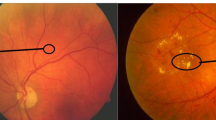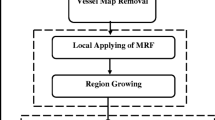Abstract
Diabetic Retinopathy (DR) is one of the most common complications of long-term diabetes. It is a progressive disease that causes retina damage. DR is asymptomatic at the early stages and can lead to blindness if it is not treated in time. Thus, patients with diabetes should be routinely evaluated through systemic screening programs using retinal photography. Automated pre-screening systems, aimed at filtering cases of patients not affected by the disease using retinal images, can reduce the specialist’ workload. Since microaneurysms (MAs) appear as a first sign of DR in retina, early detection of this lesion is an essential step in automatic detection of DR. Most of MA detection systems are based on supervised classification and are designed in two stages: MA candidate extraction and further description and classification. This work proposes a method that addresses the first stage. Evaluation of the proposed method on a test dataset of 83 images shows that the method could operate at sensitivities of 74%, 82% and 87% with a number of 92, 140 and 194 false positives per image, respectively. These results show that the methodology detects low contrast MAs with the background and is suitable to be integrated in a complete classification-based MA detection system.
Access this chapter
Tax calculation will be finalised at checkout
Purchases are for personal use only
Similar content being viewed by others
References
Guariguata, L., et al.: Global estimates of diabetes prevalence for 2013 and projections for 2035. Diabetes Res. Clin. Pract. 103(2), 137–149 (2014)
Bourne, R.R., et al.: Causes of vision loss worldwide, 1990–2010: a systematic analysis. Lancet Glob. Health 1, e339–e349 (2013)
Abramoff, M.D., et al.: Evaluation of a system for automatic detection of diabetic retinopathy from color fundus photographs in a large population of patients with diabetes. Diabetes Care 31(2), 193–198 (2008). doi:10.2337/dc07-1312
Khan, T., et al.: Preventing diabetes blindness: cost effectiveness of a screening programme using digital non-mydriatic fundus photography for diabetic retinopathy in a primary healt care setting in South Africa. Diabetes Res. Clin. Pract. 101, 170–176 (2013)
Soto-Pedre, E., Navea, A., Millan, S., Hernaez-Ortega, M.C., Morales, J., Desco, M.C., Pérez, P.: Evaluation of automated image analysis software for the detection of diabetic retinopathy to reduce the ophthalmologists’ workload. Acta Ophthalmol. 93, e52–e56 (2015). doi:10.1111/aos.12481
Mane, V.M., Jadhav, D.V.: Review: progress towards automated early stage detection of diabetic retinopathy: image analysis systems and potential. J. Med. Biol. Eng. 34, 520–527 (2014)
Mookiah, M.R.K., Acharya, U.R., Chua, C.K., Lim, C.M., Ng, E.Y.K., Laude, A.: Computer-aided diagnosis of diabetic retinopathy: a review. Comput. Biol. Med. 43(12), 2136–2155 (2013)
Walter, T., Massin, P., Erginay, A., Ordonez, R., Jeulin, C., Klein, J.-C.: Automatic detection of microaneurysms in color fundus images. Med. Image Anal. 11(6), 555–566 (2007)
Fleming, A.D., Philip, S., Goatman, K.A., Olson, J.A., Sharp, P.F.: Automated microaneurysm detection using local contrast normalization and local vessel detection. IEEE Trans. Med. Imaging 25(9), 1223–1232 (2006)
Quellec, G., Lamard, M., Josselin, P.M., Cazuguel, G., Cochener, B., Roux, C.: Optimal wavelet transform for the detection of microaneurysms in retina photographs. IEEE Trans. Med. Imaging 27(9), 1230–1241 (2008)
Hipwell, J.H., Strachan, F., Olson, J.A., McHardy, K.C., Sharp, P.F., Forrester, J.V.: Automated detection of microaneurysms in digital red-free photographs: a diabetic retinopathy screening tool. Diabetic Med. 17(8), 588–594 (2000)
Antal, B., Hajdu, A.: An ensemble-based system for microaneurysm detection and diabetic retinopathy grading. IEEE Trans. Biomed. Eng. 59(6), 1720–1726 (2012)
Oliveira, J., Minas, G., Silva, C.: Automatic detection of microaneurysm based on the slant stacking. In: Proceedings of the 26th IEEE International Symposium on Computer-Based Medical Systems, Porto, pp. 308–313 (2013). doi:10.1109/CBMS.2013.6627807
Hatanaka, Y., Inoue, T., Okumura, S., Muramatsu, C., Fujita, H.: Automated microaneurysm detection method based on double ring filter and feature analysis in retinal fundus images. IEEE (2012). ISBN: 978-1-4673- 2051-1
Lazar, I., Hajdu, A.: Retinal microaneurysm detection through local rotating cross-section profile analysis. IEEE Trans. Med. Imaging. 32(2), 400–407 (2013)
Javidi, M., et al.: Vessel segmentation and microaneurysm detection using discriminative dictionary learning and sparse representation. Comput. Methods Programs Biomed. 139 93–108 (2016)
Ganjee, R., Azmi, R., Ebrahimi Moghadam, M.: J. Med. Syst. 40, 74 (2016). doi:10.1007/s10916-016-0434-4
Marín, D., Aquino, A., Gegúndez-Arias, M.E., Bravo, J.M.: A new supervised method for blood vessel segmentation in retinal images by using gray-level and moment invariants-based features. IEEE Trans. Med. Imaging 30(1), 146–158 (2011)
Marin, D., et al: Obtaining optic disc center and pixel region by automatic thresholding methods on morphologically processed fundus images. Comput. Methods Programs Biomed. 118(2), 173–185 (2015). http://dx.doi.org/10.1016/j.cmpb.2014.11.003
Gegúndez-Arias, M., Marin, D., Bravo, J., Suero, A.: Locating the fovea center position in digital fundus images using thresholding and feature extraction techniques. Comp. Med. Imaging Graph. 37(5–6), 386–393 (2013)
Chakraborty, D.P.: Clinical relevance of the ROC and free response paradigms for comparing imaging system efficacies. Radiat. Prot. Dosimetry 139(1–3), 37–41 (2010)
Author information
Authors and Affiliations
Corresponding author
Editor information
Editors and Affiliations
Rights and permissions
Copyright information
© 2017 Springer International Publishing AG
About this paper
Cite this paper
Cortés-Ancos, E., Gegúndez-Arias, M.E., Marin, D. (2017). Microaneurysm Candidate Extraction Methodology in Retinal Images for the Integration into Classification-Based Detection Systems. In: Rojas, I., Ortuño, F. (eds) Bioinformatics and Biomedical Engineering. IWBBIO 2017. Lecture Notes in Computer Science(), vol 10208. Springer, Cham. https://doi.org/10.1007/978-3-319-56148-6_33
Download citation
DOI: https://doi.org/10.1007/978-3-319-56148-6_33
Published:
Publisher Name: Springer, Cham
Print ISBN: 978-3-319-56147-9
Online ISBN: 978-3-319-56148-6
eBook Packages: Computer ScienceComputer Science (R0)




